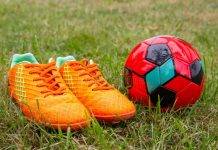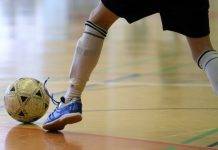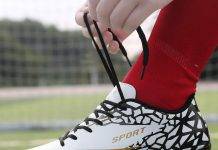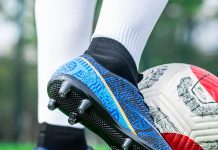When a soccer player buys a new pair of cleats, it’s an exciting time. New cleats can improve performance, provide better comfort, and enhance the overall playing experience. However, it’s essential to take specific steps after purchasing new cleats to ensure optimal performance and longevity.
One of the first things a player should do after buying new cleats is to choose the right pair for their playing style and foot shape. Understanding the materials used in the cleats and how they affect performance is also crucial. Once the right pair of cleats has been selected, it’s essential to prepare them before wearing them on the field.
Proper care and maintenance of new cleats can also help extend their lifespan and improve performance. Additionally, practicing with new cleats and adapting to different playing surfaces can help players get the most out of their new gear. By taking these steps, players can ensure that their new cleats provide maximum comfort and performance on the field.
Review contents
Key Takeaways
- Choosing the right cleats and understanding the materials are essential for optimal performance.
- Preparing new cleats before wearing them and proper care and maintenance can help extend their lifespan.
- Practicing with new cleats and adapting to different playing surfaces can improve overall performance.
Choosing the Right Cleats
When buying new cleats, choosing the right pair is crucial for performance and comfort on the field. Here are some essential factors to consider when selecting the perfect pair of cleats:
Size
First and foremost, it’s essential to ensure that the cleats fit properly. Ill-fitting cleats can cause discomfort and even lead to It’s recommended to try on cleats in person before purchasing, as sizes can vary between brands. If shopping online, check the sizing chart and read customer reviews for sizing information.
Fit Properly
In addition to size, the overall fit of the cleats is essential. The cleats should feel snug but not too tight, with enough room for the toes to move comfortably. It’s also important to consider the width of the cleats, as some brands offer wider or narrower options.
Budget
Cleats can range in price from budget-friendly to high-end options. It’s essential to set a budget before shopping and stick to it. While it may be tempting to splurge on the latest and most excellent cleats, it’s essential to consider the level of play and frequency of use. For casual players, a mid-range option may suffice, while serious players may want to invest in a higher-end pair.
Personal Preferences
Personal preferences can also play a role in choosing the right cleats. Some players prefer a particular brand or style, while others may prioritize specific features such as weight or traction. It’s important to consider what works best for the individual player.
Online
Finally, shopping online can offer a convenient option for purchasing cleats. However, it’s essential to do research and read reviews before making a purchase. It’s also important to check the return policy if the cleats do not fit properly or meet expectations.
By considering these factors, players can ensure they are choosing the right cleats for their needs and preferences.
Understanding the Materials
When purchasing new soccer cleats, it is essential to understand the different materials used in their construction. The two primary materials used are leather and synthetic materials.
Leather cleats are often more expensive but offer a superior feel and comfort. They are also more durable and can last longer than synthetic cleats. Leather cleats mold to the player’s foot, providing a custom fit that synthetic materials cannot match. However, leather cleats require more maintenance and care to keep them in good condition.
Synthetic materials are often cheaper and more lightweight than leather cleats. They can also be more durable and resistant to wear and tear. Synthetic cleats are often easier to clean and maintain than leather cleats. However, they do not offer the same comfort and fit as leather cleats.
When considering the durability of soccer cleats, the materials used play a significant role. Leather cleats can last longer than synthetic cleats, but they require more maintenance. Synthetic cleats are often more resistant to wear and tear, but they may not last as long as leather cleats.
Understanding the materials used in soccer cleats is essential for choosing the right pair. Consider the player’s needs, budget, and playing style when deciding between leather and synthetic materials.
Preparation Before Wearing
Before wearing new cleats, there are a few things that should be done to ensure the best experience on the field.
Wear Socks
It is important to wear socks with new cleats. Socks help to prevent blisters and provide additional cushioning. Ankle or tight-fitting socks are recommended to reduce the risk of slipping or sliding inside the cleats.
Break-In the Cleats
New cleats can be stiff and uncomfortable, so it is essential to break them in before wearing them for an extended period. This can be done by wearing them around the house or during light activity for short periods.
Check the Fit
It is essential to ensure the cleats fit correctly before wearing them for a game or practice. Tight-fitting cleats can cause discomfort and blisters, while loose-fitting cleats can cause slipping or sliding.
Check the Field Conditions
Before wearing new cleats, it is essential to check the field conditions. Different types of cleats are designed for different types of surfaces, so it is essential to choose the appropriate type of cleat for the field surface.
By taking these steps before wearing new cleats, players can ensure a comfortable and safe experience on the field.
The Break-In Process
Breaking in new cleats is an important step to ensure comfort and performance on the field. It is recommended to start by wearing the cleats around the house or while doing light activities such as walking or jogging. This allows the feet to get used to the fit and feel of the cleats. It also helps break in the material of the cleats, softening them up and making them more comfortable.
Another effective way to break in new cleats is to wear them during practice or workouts. This allows the player to get a feel for the cleats while also breaking them in. It is essential to ensure the cleats are the right size and comfortable before breaking them in.
Metal spikes may make it difficult to break in, but running laps or practicing with the cleats on can help adjust them to the foot shape. It is important to note that metal spikes may take longer to break in compared to rubber or plastic spikes.
To speed up the break-in process, soaking the feet, with the cleats on, in warm water can be helpful. This will soften the material of the cleats and speed up the molding process. After a few minutes, please take off the cleats and let them dry naturally. It is essential not to apply any heat to speed up the drying process.
In summary, breaking in new cleats is an important step to ensure comfort and performance on the field. Wearing them around the house or during light activities, practicing or workouts, and soaking the feet in warm water can all be effective ways to break in new cleats.
Avoiding Discomfort and Blisters
New cleats can be uncomfortable and cause blisters, ruining the soccer experience. However, several things can be done to avoid discomfort and blisters.
One of the most important things to do is to wear the cleats around the house for a few hours each day for a week before wearing them for a game or practice. This will help to break them in and allow the feet to get used to them.
Another way to avoid discomfort and blisters is to wear two pairs of socks. This can help to reduce friction between the cleats and the skin, which can cause blisters. It is also important to choose socks that are made of moisture-wicking materials to keep the feet dry.
Applying a lubricant such as Vaseline or Body Glide to the feet can also help to reduce friction and prevent blisters. This should be applied to areas prone to blisters, such as the heel and the toes.
It is also essential to make sure that the cleats fit properly. Cleats that are too tight can cause discomfort and blisters, while cleats that are too loose can cause the feet to slide inside the shoe, which can also cause blisters. A good rule of thumb is to leave about a quarter of an inch of space between the end of the shoe and the longest toe.
By taking these steps, soccer players can avoid discomfort and blisters when wearing new cleats, allowing them to focus on the game and perform at their best.
Proper Care and Maintenance
Taking care of your new cleats is essential to ensure they last as long as possible and perform at their best. Here are some tips for proper care and maintenance:
Air Dry Your Cleats
After each use, make sure to air dry your cleats. Avoid exposing them to direct sunlight or heat sources, as this can damage the material and cause them to lose shape. Instead, please leave them in a well-ventilated area to dry naturally.
Clean Your Cleats Regularly
Regular cleaning is essential to remove dirt and debris accumulating on your cleats. Use a soft-bristled brush or a damp cloth to clean the surface of your cleats gently. Avoid using harsh chemicals or abrasive materials that can damage the material.
Time Your Cleat Replacement
It’s essential to replace your cleats when they start to wear out. Look for signs of wear and tear, such as decreased traction or difficulty releasing from the pedal. Shimano recommends replacing cleats when it becomes difficult for the rider to release themselves from the pedal or when the cleat starts to release with much less effort than when it was new.
Store Your Cleats Properly
When you’re not using your cleats, store them in a cool, dry place. Avoid leaving them in a damp or humid environment, as this can cause mold or mildew to grow. You can also use a shoe bag or box to protect them from dust and other debris.
Use Glue Sparingly
If your cleats become loose or separate from the sole, you may be tempted to use glue to fix them. However, it’s important to use glue sparingly and only as a temporary fix. Overusing glue can damage the material and cause the cleats to become permanently attached to the sole.
By following these tips, you can help ensure your new cleats stay in top condition and perform at their best.
Practicing with Your New Cleats
Once you have broken in your new cleats, it’s time to start practicing with them. It’s important to gradually increase the intensity of your practice sessions to avoid any injuries or discomfort.
Start with some light drills and gradually increase the intensity as you get comfortable with your new cleats. This will also help you get used to the feel and grip of your new cleats.
As you progress, try to simulate match conditions during your practice sessions. This will help you get accustomed to the feel of your new cleats during a game.
It’s also important to pay attention to your footwork and movements while practicing with your new cleats. This will help you identify areas where you may need to adjust or improve your technique.
Overall, practicing with your new cleats is an essential step in ensuring that you perform at your best during a match. By gradually increasing the intensity of your practice sessions and paying attention to your technique, you can get the most out of your new cleats.
Adapting to Different Playing Surfaces
When it comes to playing sports, different playing surfaces can have a significant impact on how well you perform. This is especially true for sports that require specific types of footwear, such as soccer, football, and baseball. In the case of soccer, for example, players need to be able to adapt to different playing surfaces, including grass, turf, and concrete.
Grass is the most common playing surface for soccer, and players need to be able to adapt their cleats to the conditions. The length of the grass can vary, and players need to adjust their cleats accordingly. For longer grass, players may want to use cleats with longer studs to help them grip the surface better. For shorter grass, shorter studs may be more appropriate.
Turf is another playing surface that is becoming increasingly popular for soccer. Turf fields are typically made of synthetic materials, requiring a different type of cleat than grass. Turf cleats have shorter studs designed to grip the turf surface better. They also have more studs than grass cleats, which helps distribute weight evenly across the foot.
Concrete is another joint playing surface for soccer, particularly in urban areas with limited space. Concrete surfaces can be harsh on cleats, and players need to be careful not to wear down their cleats too quickly. They may want to consider using cleats with rubber soles, which can help absorb some of the shock of running on concrete.
In addition to adapting their cleats to the playing surface, players must also be aware of their position on the field. For example, defenders may need cleats with more support and protection, while forwards may want cleats that are more lightweight and designed for speed. Midfielders may want a balance of both.
Overall, adapting to different playing surfaces is an essential part of playing soccer. By choosing the right type of cleats for the conditions, players can improve their performance and reduce the risk of injury.
Frequently Asked Questions
How can I break in new cleats quickly?
Breaking in new cleats can take some time, but there are a few things you can do to speed up the process. One way is to wear your new cleats around the house briefly before using them on the field. Another way is to use warm water to soften the material and then wear them with socks for a few hours.
What is the best way to break in soccer cleats?
The best way to break in soccer cleats is to wear them gradually and consistently. Start by wearing them for short periods, and gradually increase the time you wear them. You can also use warm water to soften the material and wear them with socks for a few hours.
Can I use hot water to break in my cleats?
Yes, you can use hot water to break in your cleats. However, it is essential to be careful when using hot water, as it can damage the material if it is too hot. It is recommended to use warm water, not hot water, to soften the material.
What is the meaning of breaking in cleats?
Breaking in cleats means wearing them until they become more comfortable and conform to the shape of your feet. This process can take some time, but it is essential to break in cleats to avoid discomfort and blisters.
How long does it take to break in synthetic soccer cleats?
The time it takes to break in synthetic soccer cleats can vary depending on the individual and the specific cleats. It can take a few days to a few weeks to break in synthetic soccer cleats. It is essential to wear them gradually and consistently to ensure they conform to the shape of your feet.
Is it recommended to wear new cleats to practice?
It is recommended to wear new cleats to practice before wearing them in a game. This allows you to break them in gradually and get used to the feel of the cleats. However, it is essential to avoid wearing new cleats in a game until they are properly broken in to avoid discomfort and potential injury.
Hey, today I want to talk about things you should do when you buy new cleats.
I have worn many different soccer cleats. In the beginning, it was tough for me because they didn’t fit me right, they were tight, and sometimes I did even have blisters.
Oh god, how I hated this. Because of all this that I mentioned above, I want to share some tips you should do when you have bought a new pair of cleats.
If you have problems choosing cleats, check the best soccer cleats.
Put in a crumpled newspaper!
When you get yourself a new pair of cleats, I recommend you put them right after you get them crumpled newspaper in it.
You are probably asking why that is good. This is good because when you put the crumpled newspaper in, the cleats will expand, and you will wear them in the future.
They won’t be so tight.
Wear them before playing
Yes, I recommend wearing your cleats at home before you go for the first time on the pitch.
You can wear them if you browse on a computer or watch TV or by doing any other thing. This is good because slowly, your cleats will get used and slowly adjusted to your foot.
Pour them with water.
There is another good thing you can do, and this is pouring them with water. After doing this, try to put them on.
By doing this, your cleats will be softer and will slowly get adjusted to your foot. I think this is an upgrade to just wearing them.

Read Next – Best Soccer Cleats Under 50$
Why is all this good?
By doing all these things, you may prevent getting blisters, and your foot won’t hurt you after training.
As I mentioned above, I got many blisters during my career, and I really hate them because then you cannot play.
They were the main reason I asked people around me what to do when buying new soccer cleats. I got all this information that helped me, so I am sharing it now with you.

Read Next – Best Soccer Cleats for Strikers to Score More Goals
Let’s repeat once again!
- Put in crumpled newspaper
- Wear them before playing (at home)
- Pour them with water
Now that you know how to handle your new cleats, you should also check at best soccer cleats, cleats under 100$, cleats under 50$, cool cleats, cleats for wide feet, or at Kangaroo leather cleats, and maybe you find your favorite pair.
You may be looking for cleats for kids, cleats for girls, or cleats for boys. I hope you like the article and that you will share it on social profiles to help others.
Read Next – Find Good Size 15 Soccer Cleats!
adidas Performance Men's Copa Mundial Soccer Shoe,Black/White/Black,9.5 M US
adidas Unisex Goletto VIII Firm Ground Soccer Shoe, Core Black/White/Red, 10 US Men
$36.00 in stock
3 used from $34.56
adidas Goletto VII Firm Ground Cleats Football Shoe, core Black/Shock Pink/Shock Pink, 11 US Unisex Little Kid
adidas Unisex Goletto VIII Firm Ground Soccer Shoe, Core Black/White/Red, 7 US Men
$36.00 in stock
1 used from $35.64
Mens Soccer Shoes Soccer Cleats Women Football Cleats Tacos De Futbol para Hombre Football Shoes for Turf Futsal Shoes Cleats Football Turf Cleats Professional Football Training Boots AG FG
adidas Unisex Predator Accuracy.3 Firm Ground Soccer Shoe, Black/Black/White, 9.5 US Men
$83.26 in stock
1 used from $45.92
Soccer Ceats Mens Women Football Cleats Tacos de Futbol para Hombre Outdoor Zapatos para Futbol para Hombres High Top Cleats Turf Soccer Shoes Men Futsal Shoes Professional Soccer Cleats AG/FG
adidas Unisex Copa Pure.3 Firm Ground Soccer Shoe, Black/Black/Black, 8 US Men
$55.00 in stock
2 used from $37.27
adidas Child-Unisex Goletto VII Firm Ground Soccer Cleats - Kids Soccer Shoe
adidas Unisex Predator Accuracy.4 Flexible Ground Soccer Shoe, Black/Black/White, 10 US Men
$51.03 in stock
adidas X Cazyfast.3 Adult Firm Ground Soccer Cleats, Unisex Sizing
$89.99 in stock
Biayvisas Soccer Cleats for Mens Womens Turf Soccer Shoes Indoor Footall Cleats High Ankle TF FG Football Boots Wide Training Sneaker (1126 FG Bai, Numeric_40)
$41.60 in stock
















































